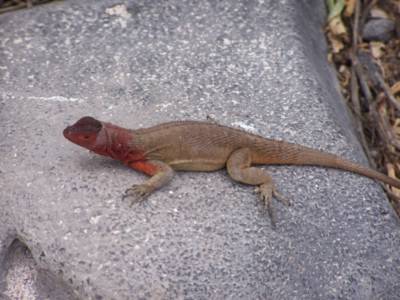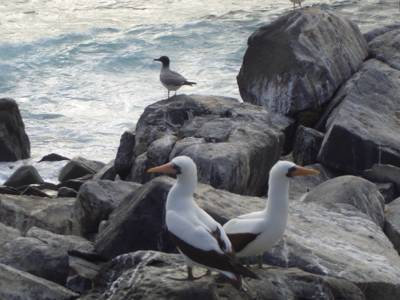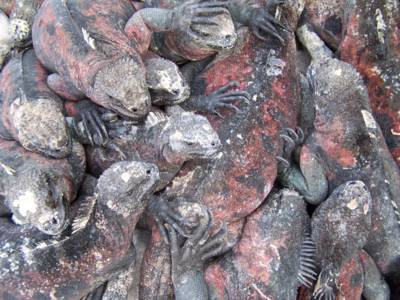
Since we’d seen so many of the larger animals on North Seymour Island, it was possible for me to pay more attention to some of the smaller critters and birds that are endemic to the Galapagos. We spotted a lava lizard with interesting coloration.

The female lava lizards we saw on Española had intense red areas on their head and neck. The males tended to be red in the body and tail. Once in their lifetimes, these lizards can drop their tail and leave it twitching to fool a predator. The tail regrows and you can see the slight difference in color between the old and new. On each island, their coloration is a bit different, based on adaptations to blend in with the land and rocks of their native island. Fortunately, they were also adept at avoiding our footsteps. They blended in so well with their environment that I usually didn’t notice them, until I was about to step on them or just past them.
Along the rocky shore, we came across a different booby - the nasca booby or the masked booby. As far as I could make out, these were different names for the same thing.

We didn’t have to clean these birds or touch up their photographs to make them look so snowy white. Their bright white heads stood out from the rocks and the water, making them easy to identify.

The shoreline was beautiful in and of itself, even if it hadn’t been teeming with birds.

There was a blowhole at one point along the shore. We had felt the spray from this blowhole as we walked the curving trail.

One of the highlights of Española was the albatross. First we saw some albatross couples. Then a couple with a juvenile. The young ones look quite different from their parents due to their baby fir. As they grow, they shed this initial layer. During the transition stage, they look like they are in the process of being shaved as hunks of fir drop off.

And finally, we encountered several couples doing their courting dance. It was very ritualistic and rhythmic. I got some great video footage of them; too bad all you get here is a couple of still shots.


Toward the end of our walk, we came upon some marine iguanas on land. They are the only iguana that swims. Their tails are broad and paddle well in the water. On Española, they have a lot of red in their coloration, but on some of the other islands, they don’t have nearly so much color. On land, they hang out in mobs, sprawled one over the other. I’d expect to find a football at the bottom of the pile.

They have very tough nails and floppy fingers, which they can use to climb up and down the rocks to find that perfect resting spot.

No comments:
Post a Comment